Input interpretation

methylamine
Chemical names and formulas

formula | CH_3NH_2 Hill formula | CH_5N name | methylamine IUPAC name | methanamine alternate names | aminomethane | carbinamine | mercurialin | methanamine | monomethylamine mass fractions | C (carbon) 38.7% | H (hydrogen) 16.2% | N (nitrogen) 45.1%
Lewis structure
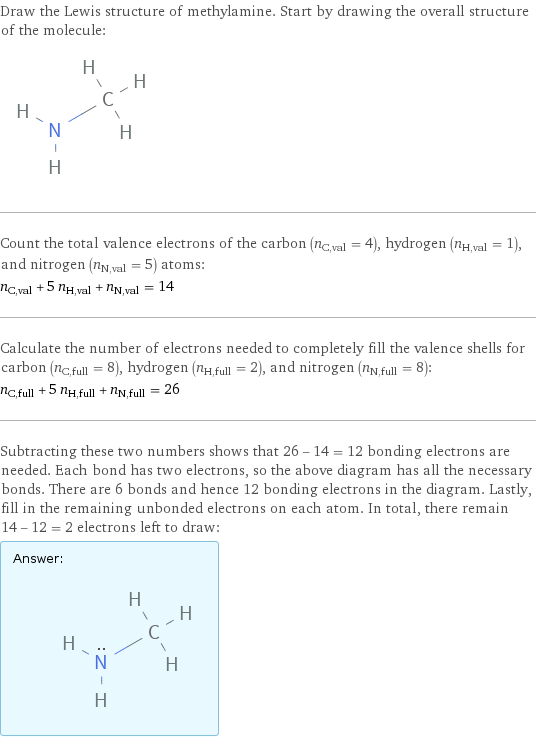
Draw the Lewis structure of methylamine. Start by drawing the overall structure of the molecule: Count the total valence electrons of the carbon (n_C, val = 4), hydrogen (n_H, val = 1), and nitrogen (n_N, val = 5) atoms: n_C, val + 5 n_H, val + n_N, val = 14 Calculate the number of electrons needed to completely fill the valence shells for carbon (n_C, full = 8), hydrogen (n_H, full = 2), and nitrogen (n_N, full = 8): n_C, full + 5 n_H, full + n_N, full = 26 Subtracting these two numbers shows that 26 - 14 = 12 bonding electrons are needed. Each bond has two electrons, so the above diagram has all the necessary bonds. There are 6 bonds and hence 12 bonding electrons in the diagram. Lastly, fill in the remaining unbonded electrons on each atom. In total, there remain 14 - 12 = 2 electrons left to draw: Answer: | |
3D structure

3D structure
Basic properties
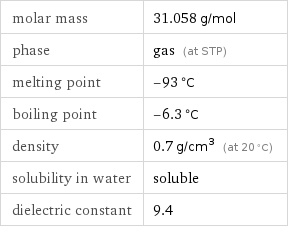
molar mass | 31.058 g/mol phase | gas (at STP) melting point | -93 °C boiling point | -6.3 °C density | 0.7 g/cm^3 (at 20 °C) solubility in water | soluble dielectric constant | 9.4
Hydrophobicity and permeability properties

experimental LogP hydrophobicity | -0.57 predicted LogP hydrophobicity | -1.05 predicted LogS | 1.07
Basic drug properties

approval status | experimental | small molecule
Gas properties (at STP)
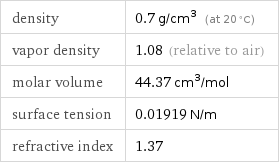
density | 0.7 g/cm^3 (at 20 °C) vapor density | 1.08 (relative to air) molar volume | 44.37 cm^3/mol surface tension | 0.01919 N/m refractive index | 1.37
Units

Thermodynamic properties
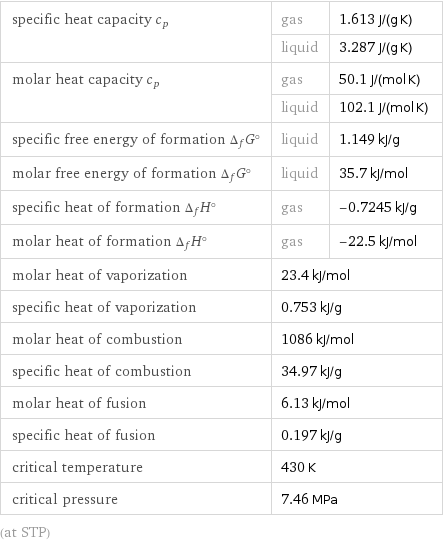
specific heat capacity c_p | gas | 1.613 J/(g K) | liquid | 3.287 J/(g K) molar heat capacity c_p | gas | 50.1 J/(mol K) | liquid | 102.1 J/(mol K) specific free energy of formation Δ_fG° | liquid | 1.149 kJ/g molar free energy of formation Δ_fG° | liquid | 35.7 kJ/mol specific heat of formation Δ_fH° | gas | -0.7245 kJ/g molar heat of formation Δ_fH° | gas | -22.5 kJ/mol molar heat of vaporization | 23.4 kJ/mol | specific heat of vaporization | 0.753 kJ/g | molar heat of combustion | 1086 kJ/mol | specific heat of combustion | 34.97 kJ/g | molar heat of fusion | 6.13 kJ/mol | specific heat of fusion | 0.197 kJ/g | critical temperature | 430 K | critical pressure | 7.46 MPa | (at STP)
Chemical identifiers
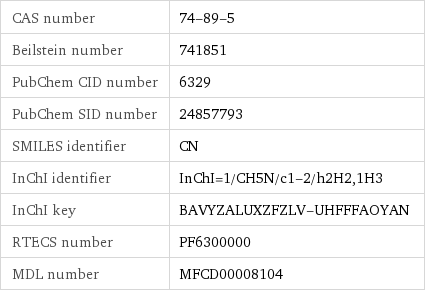
CAS number | 74-89-5 Beilstein number | 741851 PubChem CID number | 6329 PubChem SID number | 24857793 SMILES identifier | CN InChI identifier | InChI=1/CH5N/c1-2/h2H2, 1H3 InChI key | BAVYZALUXZFZLV-UHFFFAOYAN RTECS number | PF6300000 MDL number | MFCD00008104
NFPA label

NFPA label

NFPA health rating | 3 NFPA fire rating | 4 NFPA reactivity rating | 0
Safety properties
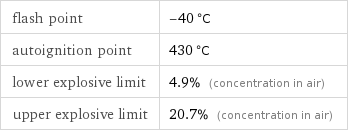
flash point | -40 °C autoignition point | 430 °C lower explosive limit | 4.9% (concentration in air) upper explosive limit | 20.7% (concentration in air)

DOT hazard class | 2.3 DOT numbers | 1235